Gigantic Neolithic Newgrange Monument: A Temple, Astronomical Observatory Or Ancient Tomb?
A. Sutherland - AncientPages.com - In Ireland, the chambered round cairn of Newgrange, with its quartz walls and a passage aligned towards the midwinter sunrise, was placed inside a circle of over thirty massive blocks of stone. It is a fascinating ancient construction located about 26 miles north of Dublin, Ireland.
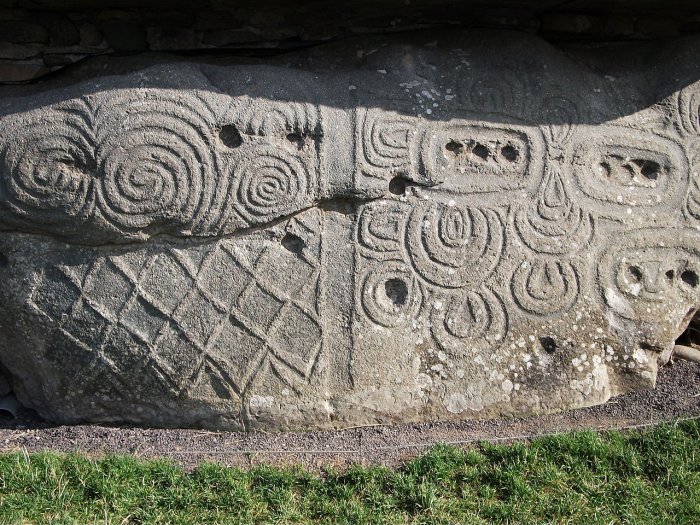
Stone at Newgrange - Megalithic art on one of the kerbstones - Image credit: Johnbod - - CC BY-SA 3.0
The gigantic Neolithic tomb of Newgrange (in Irish: Si An Bhru) is one of the world's most impressive prehistoric monuments, probably constructed about 5,100 years ago. The structure is older than the Great Pyramid of Giza and the Stonehenge enormous trilithons.
First written references to Newgrange appear as early as 656 AD in medieval Irish annals, and during the Roman times, Newgrange was already a ruin.
It is believed that the ancient Celts considered the place as an abode of spirits and a former home of their mythological ancestors, "the peoples of the goddess Danu" (Tuatha Dé Danann). Danu was a mother goddess associated with Anu, another Celtic mother goddess who sponsored fertility and prosperity in the land. Some Celtic traditions say that Newgrange belonged to the Daghda ("the good god").
The Celts believed the abandoned prehistoric tombs, such as Newgrange, were portals ('sidh') to the mysterious and dangerous Otherworld, with its subterranean realms and hidden places within the hills.
View of Newgrange, archaeological site of Brú na Bóinne. Image credit: Jean Housen - CC BY-SA 3.0
Professor Michael J. O'Kelly excavated and restored the megalithic passage tomb at Newgrange from 1962 to 1975. He discovered that the builders of Newgrange deliberately oriented the passage so that each year around the winter solstice, the rising Sun's rays would shine through a unique aperture he called a roof box to illuminate the chamber.
Newgrange has a diameter of about 264 ft and is almost circular. Stones layered with turf form the Newgrange's mound, surrounded by 97 large stones, the so-called 'kerbstones' (curbstones), some of which are richly decorated.
Surrounding the Newgrange mound is a ring of 12 standing stones, up to 8 feet in height. There were probably approximately 35 upright stones, but they were destroyed or removed over time.
Newgrange is famous for a spectacular phenomenon occurring at the site every year for a few days around the 21st or 22nd of December. The entrance to the Newgrange passage tomb contains a doorway with two standing stones and a horizontal lintel.
A section of the passage leading towards the chamber of the Newgrange passage tomb in Ireland. Image credit: O'Dea - CC BY-SA 4.0
Above this doorway is the 'roof box' or 'lightbox.' Every year after 9 am (on the early morning of the winter solstice – the shortest day of the year) – the newly risen Sun sends a shaft of sunlight through the Newgrange' light box', creating a narrow beam of light illuminating the central chamber located at the back of the tomb.
The phenomenon lasts 17 minutes, the beam of light slowly disappears, and the chamber is dark again.
It is commonly agreed that the Iron Age Celts did not build Newgrange, but it was unclear how old it really was.
Finally, Professor O'Kelly excavated and restored Newgrange from 1962 to 1975. He discovered that those who built the Newgrange deliberately oriented the passage so that each year around midwinter, the rising Sun's rays would shine through a unique aperture to illuminate the chamber.
Sketch of a cross section of the Newgrange passage grave made by William Frederick Wakeman (d. 1900). Screen capture of PDF version of the 1903 edition converted into black and white and adjusted for contrast and brightness. William Frederick Wakeman - Wakeman's handbook of Irish antiquities (1903). p. 85. - Public Domain
The stone chamber and mound at Newgrange in Ireland has a 'lightbox' allowing the sunrise to be glimpsed briefly on a midwinter day.
According to radiocarbon dating conducted by O'Kelly, Newgrange was constructed in the last centuries of the fourth millennium BC, probably around 3200 BC.
The Newgrange monument's primary functions as a tomb, an astronomical observatory, or an ancient temple celebrating the Sun's union with Mother Earth are often disputed.
Written by – A. Sutherland AncientPages.com Staff Writer
Updated on December 19, 2022
Copyright © AncientPages.com All rights reserved. This material may not be published, broadcast, rewritten or redistributed in whole or part without the express written permission of AncientPages.com
Expand for referencesMore From Ancient Pages
-
 Zuni Indians Bravely Fought For Their Ancient Culture, Traditions And Respect For Their Ancestors
Featured Stories | Mar 14, 2018
Zuni Indians Bravely Fought For Their Ancient Culture, Traditions And Respect For Their Ancestors
Featured Stories | Mar 14, 2018 -
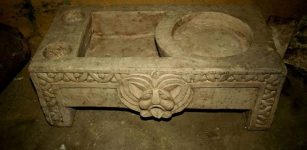 Roman-Era Residence Unearthed In Ancient Capital Of Memphis, Egypt
Archaeology | Sep 27, 2018
Roman-Era Residence Unearthed In Ancient Capital Of Memphis, Egypt
Archaeology | Sep 27, 2018 -
 When Giants Ruled North America – Encounters With Mysterious Races Of Giants – Part 1
Civilizations | Nov 20, 2018
When Giants Ruled North America – Encounters With Mysterious Races Of Giants – Part 1
Civilizations | Nov 20, 2018 -
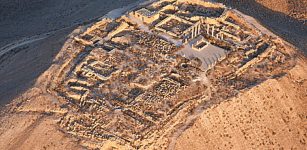 The 2,000-Year-Old Citadel Of Machaerus – A New Look For An Ancient Site
Civilizations | Oct 30, 2015
The 2,000-Year-Old Citadel Of Machaerus – A New Look For An Ancient Site
Civilizations | Oct 30, 2015 -
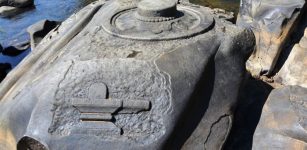 Mystery Of Ancient Carved Shiva Lingas In India And Cambodia
Featured Stories | Oct 12, 2015
Mystery Of Ancient Carved Shiva Lingas In India And Cambodia
Featured Stories | Oct 12, 2015 -
 Hazelnuts -‘Time Capsule’ To Reconstruct Landscape Of Ancient Forests In Sweden
Archaeology | Mar 5, 2024
Hazelnuts -‘Time Capsule’ To Reconstruct Landscape Of Ancient Forests In Sweden
Archaeology | Mar 5, 2024 -
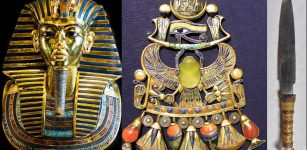 King Tut’s Cosmic Scarab Brooch And Dagger Linked To Meteorite’s Crash 28 Million Years Ago
Artifacts | Jun 17, 2021
King Tut’s Cosmic Scarab Brooch And Dagger Linked To Meteorite’s Crash 28 Million Years Ago
Artifacts | Jun 17, 2021 -
 Valentine’s Day’s Connection With Love Was Probably Invented By Chaucer And Other 14th-Century Poets
Ancient Traditions And Customs | Feb 14, 2023
Valentine’s Day’s Connection With Love Was Probably Invented By Chaucer And Other 14th-Century Poets
Ancient Traditions And Customs | Feb 14, 2023 -
 Stonehenge Is Older Than Mankind – Archaeologist Suggests
Archaeology | Apr 12, 2018
Stonehenge Is Older Than Mankind – Archaeologist Suggests
Archaeology | Apr 12, 2018 -
 Egyptian Priest Sonchis Of Sais And His Story About Atlantis – Were The Shemsu Hor Survivors Of A Great Catastrophe That Ended The Ice Age?
Civilizations | Jun 8, 2017
Egyptian Priest Sonchis Of Sais And His Story About Atlantis – Were The Shemsu Hor Survivors Of A Great Catastrophe That Ended The Ice Age?
Civilizations | Jun 8, 2017 -
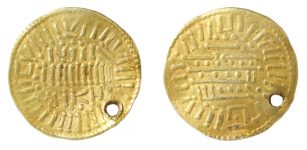 Vikings May Have Made Imitation Gold Dinar Found In Morston, Norfolk – Expert Says
Archaeology | Apr 5, 2023
Vikings May Have Made Imitation Gold Dinar Found In Morston, Norfolk – Expert Says
Archaeology | Apr 5, 2023 -
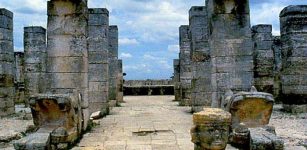 ‘Chac Mool’ – Intriguing Life-Size Figure Carved In Single Stone
Featured Stories | Mar 5, 2016
‘Chac Mool’ – Intriguing Life-Size Figure Carved In Single Stone
Featured Stories | Mar 5, 2016 -
 Strangest Maps Ever Created – You Have Never Seen Our World Like This!
Featured Stories | May 18, 2022
Strangest Maps Ever Created – You Have Never Seen Our World Like This!
Featured Stories | May 18, 2022 -
 Enigma Of Étienne Le Ray – Unusual Vagabond Prophet Nicknamed Nostradamus Of Brittany
Featured Stories | Sep 28, 2020
Enigma Of Étienne Le Ray – Unusual Vagabond Prophet Nicknamed Nostradamus Of Brittany
Featured Stories | Sep 28, 2020 -
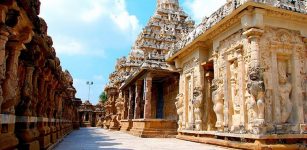 Remarkable Kailashanatha Temple And Unique Passage Of Life Cycle Including Aging, Death And Rebirth
Civilizations | Mar 26, 2017
Remarkable Kailashanatha Temple And Unique Passage Of Life Cycle Including Aging, Death And Rebirth
Civilizations | Mar 26, 2017 -
 Scientific Disagreement Over The Bronze Age Tin Ingots From The Uluburun Shipwreck
Archaeology | Sep 25, 2023
Scientific Disagreement Over The Bronze Age Tin Ingots From The Uluburun Shipwreck
Archaeology | Sep 25, 2023 -
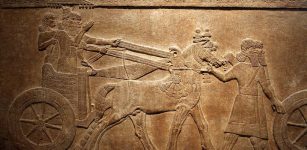 Pax Assyriaca: Important Time For The Neo Assyrian Empire And Surrounding Regions
Ancient History Facts | Aug 11, 2016
Pax Assyriaca: Important Time For The Neo Assyrian Empire And Surrounding Regions
Ancient History Facts | Aug 11, 2016 -
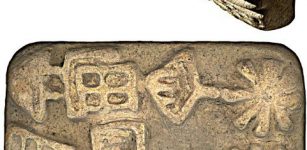 Royal Inscription Of Naram-Sîn Of Akkad: The First Ancient King To Use Blocks For Printing Bricks
Artifacts | Jul 28, 2016
Royal Inscription Of Naram-Sîn Of Akkad: The First Ancient King To Use Blocks For Printing Bricks
Artifacts | Jul 28, 2016 -
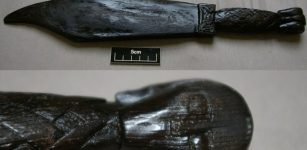 1,000-Year-Old Viking Weaver’s Sword Reveals Its Secrets
Archaeology | Apr 17, 2022
1,000-Year-Old Viking Weaver’s Sword Reveals Its Secrets
Archaeology | Apr 17, 2022 -
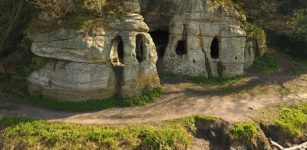 Anchor Church Caves – Has The Home Of Anglo-Saxon King Eardwulf And Saint Hardulph Been Found?
Archaeology | Jul 23, 2021
Anchor Church Caves – Has The Home Of Anglo-Saxon King Eardwulf And Saint Hardulph Been Found?
Archaeology | Jul 23, 2021



